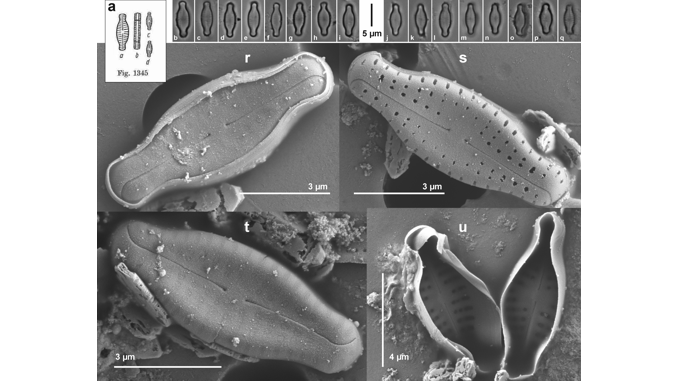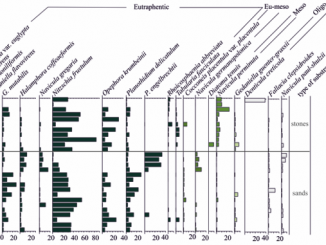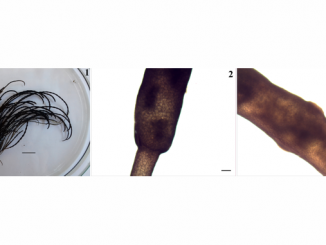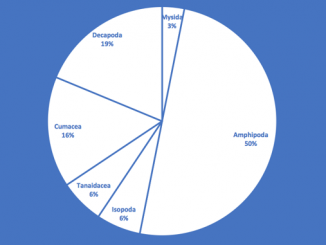
Paper category: Original research paper
Corresponding author: Giuseppina Grazia Lai (laigg@uniss.it)
DOI: 10.2478/ohs-2019-0011
Received: 08/09/2018
Accepted: 26/10/2018
Full text: here
Citation (APA style): Lai, G., Ector, L., Padedda, B., et al. (2019). Chamaepinnularia thermophila (Bacillariophyceae): synonymy with Navicula tongatensis Hustedt and update of its geographic distribution and ecology. Oceanological and Hydrobiological Studies, 48(2), pp. 105-115. Retrieved 3 Oct. 2019, from doi:10.1515/ohs-2019-0011
Abstract
Chamaepinnularia thermophila is a small and poorly known diatom species. After the first description from a hot spring in Guadalupe in 1952, its presence appeared to be limited to a few other springs of the French Antilles. The objective of this study is to report new information on aspects of taxonomy, distribution and ecology of this species. Accurate analysis under light and scanning electron microscope of the material collected on different substrates (cobbles, macrophytes and fine sediments) from a thermo-mineral spring of Sardinia (Italy) allowed us to document the first record of the species in the Mediterranean area. Furthermore, the comparison with Navicula tongatensis from Hustedt’s original material, carried out because of their similarity, revealed identical morphological characteristics suggesting their consequent synonymy. Based on the information available in the literature and our data, C. thermophila is a rare species present mainly in tropical areas, in thermal springs with alkaline pH, medium to high conductivity and low to moderate nutrient content. The occurrence of the species at sites with very different environmental characteristics seems unusual, but it could indicate a broader ecological range. This study contributes to the standardization of the nomenclature used for this species so far and provides the first framework on its global geographic distribution and ecology.
Giuseppina Grazia Lai
Luc Ector
Bachisio Mario Padedda
Antonella Lugliè
Carlos Eduardo Wetzel
References
APAT-IRSA & CNR. (2003). Metodi analitici per le acque. [Analytical methods for the waters]. Rome: I.G.E.R. srl. (Manuali e Linee Guida 29/2003. ISBN 88-448-0083-7). (In Italian).
ASCONIT Consultants. (2015). Étude de la biodiversité du peuplement diatomique des sources hydrothermales de la Martinique. [Study of the biodiversity of diatom assemblages from hydrothermal springs of Martinique]. Rapport final. DEAL Martinique: Office de l’Eau de la Martinique (E2819). (In French).
Bacciu, M.P. (2009). Le sorgenti di San Giovanni Su Anzu e del sistema carsico del Supramonte: Considerazioni sui circuiti e sulle zone di ricarica. [The San Giovanni Su Anzu springs and the Supramonte karst system: Considerations on circuits and recharge areas].Unpublished master's thesis, University of Sassari, Sassari, Italy. (In Italian).
Bourrelly, P. & Manguin, E. (1952). Algues d'eau douce de la Guadeloupe et dépendances. [Freshwater algae from Guadeloupe and outbuildings]. Paris: Centre National de la Recherche Scientifique, Société d’Edition d’Enseignement Supérieur. (In French).
Brombach, T., Marini, L. & Hunziker, J.C. (2000). Geochemistry of the thermal springs and fumaroles of Basse-Terre Island, Guadeloupe, Lesser Antilles. Bulletin of Volcanology 61(7): 477–490. DOI: 10.1007/PL00008913.
Cantonati, M. & Lange-Bertalot, H. (2009). On the ultrastructure of Chamaepinnularia schauppiana Lange-Bertalot & Metzeltin (Naviculaceae s. l.). Diatom Research 24(1): 225–231. DOI: 10.1080/0269249X.2009.9705793.
Cantonati, M., Füreder, L., Gerecke, R., Jüttner, I. & Cox, E.J. (2012). Crenic habitats, hotspots for freshwater biodiversity conservation: toward an understanding of their ecology. Freshwater Science 31(2): 463–480. DOI: 10.1899/11-111.1.
Cavacini, P., Tagliaventi, N. & Fumanti, B. (2006). Morphology, ecology and distribution of an endemic Antarctic lacustrine diatom: Chamaepinnularia cymatopleura comb. nov. Diatom Research 21(l): 57–70. DOI: 10.1080/0269249X.2006.9705651.
Cholnoky, B.J. (1966). Diatomeen assoziationen aus einigen Quellen in Südwest-Afrika und Bechuanaland. [Diatom associations from some springs in Southwest Africa and Bechuanaland]. Nova Hedwigia Beihefte 21: 163–244. (In German).
Cocquyt, C. (2007). Diatom diversity in Hausburg Tarn, a glacial lake on Mount Kenya, East Africa. Diatom Research 22(2): 255–285. DOI: 10.1080/0269249X.2007.9705715.
De Waele, J. & Grafitti, G. (2004). Geodiversity and biodiversity of karst landscapes: the example of Sardinia. In: Proceedings of the International Conference on Natural and Cultural Landscapes: the Geological Foundation, 9–11September 2002 (pp. 69–72). Dublin, Ireland: Royal Irish Academy.
Eulin-Garrigue, A., Lefrançois, E., Delmas, F., Coste, M., Gueguen, J. et al. (2017). Flore Diatomées des Antilles Françaises. [Diatom Flora of the French Antilles]. ASCONIT, Office de l’Eau Martinique, Office de l’Eau Guadeloupe. (PUB00056933). (In French).
Fiorentino, E., Curioni, S. & Pisano, C. (2017). The common ground of thermal baths. WIT Transactions on Ecology and the Environment 216: 287–297. DOI: 10.2495/WS170281.
Hustedt, F. (1934). Die Diatomeenflora von Poggenpohls Moor bei Dötlingen in Oldenburg. [The Diatom flora of Poggenpohls Moor near Dötlingen in Oldenburg]. Abhandlungen und Vorträgen der Bremer Wissenschaftlichen Gesellschaft. 8/9: 362–403. (In German).
Hustedt, F. (1942). Aërophile Diatomeen in der nordwestdeutschen Flora. [Aerophilous diatoms in the northwest German flora]. Berichte der Deutschen Botanischen Gesellschaft 60(1): 55–73. (In German).
Hustedt, F. (1962). Die Kieselalgen Deutschlands, Osterreichs und der Schweiz unter Berücksichtigung der übrigen Länder Europas sowie der angrenzenden Meeresgebiete. [The diatoms of Germany, Austria and Switzerland, taking into account the other European countries and the adjacent marine areas]. In L. Rabenhorst (Ed.), Kryptogamen-Flora von Deutschland, Österreich und der Schweiz (pp. 161–348). Leipzig: Akademische Verlagsgesellschaft Geest & Portig K.-G. (In German).
ISPRA. (2014). Metodi biologici per le acque superficali interne. [Biological methods for inland surface waters]. Rome: ISPRA. (Manuali e Linee Guida 111/2014). (In Italian).
Kelly, M.G., Cazaubon, A., Coring, E., Dell’Uomo, A., Ector, L. et. al. (1998). Recommendations for the routine sampling of diatoms for water quality assessments in Europe. Journal of Applied Phycology 10: 215–224. DOI: 10.1023/A:1008033201.
Kociolek, J.P., Balasubramanian, K., Blanco, S., Coste, M., Ector, L. et. al. (2018). DiatomBase. Retrieved September 5, 2018, from http://www.diatombase.org.
Krasske, G. (1929). Beiträge zur Kenntnis der Diatomeenflora Sachsens. [Contributions to the knowledge of the diatom flora of Saxony]. Botanisches Archiv. 27(3/4): 348–380. (In German).
Lange-Bertalot, H. & Metzeltin, D. (1996). Indicators of oligotrophy – 800 taxa representative of three ecologically distinct lake types. Carbonate buffered – Oligodystrophic – weakly buffered soft water. In H. Lange-Bertalot (Ed.), Iconographia Diatomologica. Annotated diatom micrographs Vol. 2. Ecology, Diversity, Taxonomy. (pp. 1–390). Königstein: Koeltz Scientific Books.
Loseva, E. (1997). Freshwater Pleistocene Diatom assemblages of Northeastern Europe. Diatom Research 12(2): 263–278. DOI: 10.1080/0269249X.1997.9705420.
Metzeltin, D. & Lange-Bertalot, H. (1998). Tropical diatoms of South America I. About 700 predominantly rarely known or new taxa representative of the neotropical Flora. In H. Lange-Bertalot (Ed.), Iconographia Diatomologica. Annotated diatom micrographs Vol. 5. Diversity, Taxonomy, Geobotany. (pp. 1–690). Königstein: Koeltz Scientific Books.
Metzeltin, D. & Lange-Bertalot, H. (2007). Tropical diatoms of South America II. Special remarks on biogeographic disjunction. In H. Lange-Bertalot (Ed.), Iconographia Diatomologica. Annotated Diatom Micrographs. Vol. 18. Diversity, Taxonomy, Biogeography. (pp. 1–879). Ruggell [Liechtenstein]: A.R.G. Gantner.
Mogna, M., Cantonati, M., Andreucci, F., Angeli, N., Berta, G. et al. (2015). Diatom communities and vegetation of springs in the south-western Alps. Acta Botanica Croatica 74(2): 265–285. DOI: 10.1515/botcro-2015-0024.
Mucedda, M. & Fancello, L. (2002). La Grotta de Sos Jocos o Grotta de Su Anzu (Dorgali). [The Cave of Sos Jocos or Grotta de Su Anzu (Dorgali)]. Sardegna Speleologica. 19: 2–17. (In Italian).
Noga, T. & Rybak, M. (2017). First record of Pinnularia subinterrupta Krammer & Schroeter in Poland-a rare species in Europe. Biodiversity: Research and Conservation 45(1): 17–21. DOI: 10.1515/biorc-2017-0002.
Petersen, J.B. (1915). Studier over Danske aërofile Algen. Det Kongelige Danske videnskabernes selskabs skrifter. [Studies of aerial diatoms in Denmark]. Naturvidenskabelig og mathematisk afdeling 12(7): 269–380. (In German).
Petersen, J.B. (1928). The aerial algae of Iceland. In L.K. Rosenvinge & E. Warming (Eds.), The Botany of Iceland (pp. 325–447). København: H.H. Thieles Bogtrykkeri.
Pringle, C.M., Anderson, E.P., Ardón M., Bixby R.J., Connelly S. et. al. 2016. Rivers of Costa Rica. In M. Kappelle (Ed.), Costa Rican Ecosystems (pp. 621–655). London[Chicago]: The University of Chicago Press.
Strickland, J.D.H. & Parsons, T.R. (1972). A Practical Handbook of Seawater Analysis. Bulletin 167. Ottawa: Fisheries Research Board of Canada.
Van de Vijver, B. & Cox, E.J. (2013). New and interesting small-celled naviculoid diatoms (Bacillariophyceae) from a lava tube cave on Île Amsterdam (TAAF, Southern Indian Ocean). Cryptogamie Algologie 34(1): 37–47. DOI: 10.7872/crya.v34.iss1.2013.37.
Van de Vijver, B., Sterken, M., Vyverman, W., Mataloni, G., Nedbalová, L. et al. (2010). Four new non–marine diatom taxa from the Subarctic and Antarctic regions. Diatom Research 25(2): 431–443. DOI: 10.1080/0269249X.2010.9705861.
Vanormelingen, P., Verleyen, E. &·Vyverman, W. (2008). The diversity and distribution of diatoms: from cosmopolitanism to narrow endemism. Biodiversity and Conservation 17(2): 393–405. DOI: 10.1007/s10531-007-9257-4.
Veselá, J. (2009). Spatial heterogeneity and ecology of algal communities in an ephemeral sandstone stream in the Bohemian Switzerland National Park, Czech Republic. Nova Hedwigia 88(3–4): 531–547. DOI: 10.1127/0029-5035/2009/0088-0531.
Veselá, J. & Johansen, J.R. (2009). The diatom flora of ephemeral headwater streams in the Elbsandsteingebirge region of the Czech Republic. Diatom Research 24(2): 443–477. DOI: 10.1080/0269249X.2009.9705813.
Werum, M. (2001). Die Kieselalgengesellschaften in Quellen: Abhängigkeit von Geologie und anthropogener Beeinflussung in Hessen (Bundesrepublik Deutschland). [The diatom communities in springs: dependence on geology and anthropogenic influence in Hesse (Federal Republic of Germany)]. Wiesbanden: Schriftenreihe Hessisches Landesamt für Umwelt und Geologie. (In German).
Wetzel, C.E, & Ector, L. (2016). On the identity of Chamaepinnularia thermophila comb. nov. (Bacillariophyceae) from a Neotropical thermal spring. Phytotaxa 260(1): 95–97. DOI: 10.11646/phytotaxa.260.1.11.
Wetzel, C.E., Martínez-Carreras, N., Hlúbiková, D., Hoffmann, L., Pfister, L. et al. (2013). New combinations and type analysis of Chamaepinnularia species (Bacillariophyceae) from aerial habitats. Cryptogamie Algologie 34(2): 149–168. DOI: 10.782/crya.v34.iss2.2013.149.
Winkler, L.W. (1888). Die Bestimmung des in Wasser gelösten Sauerstoffen. Berichte der Deutschen Chemischen Gesellschaft. 21: 2843–2855.
Witkowski, A., Lange-Bertalot, H. & Metzeltin, D. (2000). Diatom flora of marine coasts. In: H. Lange-Bertalot (Ed.), Iconographia Diatomologica. Annotated Diatom Micrographs. Vol.7. Diversity, Taxonomy, Identification. (pp. 1–925). Königstein: A.R.G. Gantner Verlag K.G.
Wydrzycka,U. & Lange-Bertalot, H. (2001). Las diatomeas (Bacillariophyceae) acidófilas del río Agrio y sitios vinculados con su cuenca, volcán Poás, Costa Rica. [Acidophilous diatoms (Bacillariophyceae) of the Agrio river and sites linked to its basin, Poás volcano, Costa Rica]. Brenesia. 55–56: 1–68. (In Spanish).
Żelazna-Wieczorek, J. & Olszyński, R.M. (2016).Taxonomic revision of Chamaepinnularia krookiformis Lange–Bertalot et Krammer with a description of Chamaepinnularia plinskii sp. nov. Fottea 16(1): 112–121. DOI: 10.5507/fot.2016.001.




Bądź pierwszy, który skomentuje ten wpis